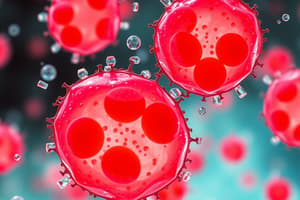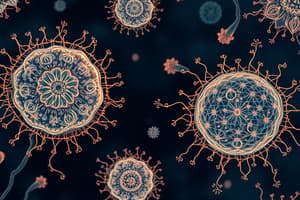Podcast
Questions and Answers
What is the key benefit of being multicellular?
What is the key benefit of being multicellular?
- The ability to grow cells larger
- The ability to exceed body limits caused by the SA:Vol ratio (correct)
- The ability to divide continuously
- The ability to form complex cell types
What is the result of cell specialization in multicellular organisms?
What is the result of cell specialization in multicellular organisms?
- Cells become less efficient
- Cells do a large number of functions moderately efficiently
- Each cell does a small number of functions extremely efficiently (correct)
- Cells become non-functional
What is true about stem cells?
What is true about stem cells?
- They are specialized cells
- They can change their function after differentiating
- They can only differentiate into one cell type
- They are unspecialized cells with the ability to differentiate (correct)
What is the difference between totipotent and pluripotent stem cells?
What is the difference between totipotent and pluripotent stem cells?
What happens when a stem cell differentiates?
What happens when a stem cell differentiates?
What is the result of repeated cell division and grouping of similar cell types?
What is the result of repeated cell division and grouping of similar cell types?
What is the primary function of the process of excretion in cells?
What is the primary function of the process of excretion in cells?
What is unique about the structure of mature red blood cells in eukaryotes?
What is unique about the structure of mature red blood cells in eukaryotes?
What is the term for the process by which cells respond to changes in their environment?
What is the term for the process by which cells respond to changes in their environment?
What is the purpose of homeostasis in cells?
What is the purpose of homeostasis in cells?
What happens to the nucleus during the development of phloem sieve tube elements?
What happens to the nucleus during the development of phloem sieve tube elements?
What is the primary reason why mature red blood cells have a short lifespan of 100-120 days?
What is the primary reason why mature red blood cells have a short lifespan of 100-120 days?
What is the primary function of the cell membrane?
What is the primary function of the cell membrane?
What is the characteristic of skeletal muscle cells that makes them atypical?
What is the characteristic of skeletal muscle cells that makes them atypical?
What is the term for the process of adding carbohydrate chains to phospholipids and proteins?
What is the term for the process of adding carbohydrate chains to phospholipids and proteins?
What type of molecules are able to pass through the cell membrane by simple diffusion?
What type of molecules are able to pass through the cell membrane by simple diffusion?
What is the function of aquaporins in cells?
What is the function of aquaporins in cells?
What is the term for the movement of particles from low to high concentrations, requiring energy?
What is the term for the movement of particles from low to high concentrations, requiring energy?
What is the advantage of compartmentalization in eukaryotic cells?
What is the advantage of compartmentalization in eukaryotic cells?
What is the characteristic of sieve tube elements that makes them atypical?
What is the characteristic of sieve tube elements that makes them atypical?
What is the function of peripheral proteins in the cell membrane?
What is the function of peripheral proteins in the cell membrane?
What is the term for the movement of particles down their concentration gradient, without requiring energy?
What is the term for the movement of particles down their concentration gradient, without requiring energy?
Flashcards are hidden until you start studying
Study Notes
Life Processes
- Seven essential life processes: homeostasis, metabolism, nutrition, excretion, growth, response to stimuli, and reproduction
Atypical Cells in Eukaryotes
- Atypical cells in eukaryotes: red blood cells, phloem sieve tube elements, skeletal muscle cells, and aseptate fungal hyphae
- Red blood cells are enucleated, lacking a nucleus, allowing them to be smaller and more flexible
- Phloem sieve tube elements have large pores for sap to pass through, and their nucleus and most cell contents break down during development
- Skeletal muscle cells are multinucleated, with long cylindrical fibers formed from the fusion of individual cells
- Aseptate fungal hyphae lack septa and cell membranes between cells, resulting in a large multinucleate structure
Cell Specialization
- In multicellular organisms, cells become specialized to form different cell types
- Each cell does a small number of functions extremely efficiently
- Different cell types interact to achieve complex functions
Differentiation
- Every cell in a multicellular organism is a clone of an original parent cell (except gametes)
- All cells that come from this will have identical DNA
- Certain cells will express specific genes, while others will express other genes
Stem Cells
- Stem cells are unspecialized cells with two key properties: self-renewal and potency
- When a stem cell differentiates and becomes specialized, it cannot change again
- Stem cells are limited in availability
Types of Stem Cells
- Three types of stem cells: totipotent, pluripotent, and multipotent
- Totipotent stem cells can form any cell type and divide into new organisms
- Pluripotent stem cells can form any cell type
- Multipotent stem cells can form a number of closely related cell types
Cell Membranes
- Cell membranes enclose the cellular contents, separating them from the external environment
- Cell membranes have two properties: semi-permeability and selectivity
- Cell membranes have two major components: phospholipids and proteins
Phospholipids
- Phospholipids have a polar head (glycerol and phosphate) and two nonpolar tails (fatty acids)
- The head is hydrophilic, and the tails are hydrophobic, making phospholipids amphipathic molecules
- Phospholipids spontaneously form bilayers in water, with tails forming the center and heads on the outside
Membrane Proteins
- The phospholipid bilayer is embedded with proteins, forming a mosaic
- Membrane proteins can be integral (permanently attached to the bilayer) or peripheral (attaching to the membrane surface)
- Membrane proteins serve a variety of functions: junctions, enzymes, transport, recognition, anchorage, and transduction
Glycosylation
- Phospholipids and proteins can have carbohydrate chains added to them, forming glycolipids and glycoproteins
- The carbohydrate extends to the extracellular side of the membrane and can function for adhesion and recognition
Membrane Transport
- Simple diffusion occurs in cells for particles that can pass between the phospholipids
- Osmosis is the movement of water into and out of cells, which is possible through aquaporins, water channel proteins
- Facilitated diffusion occurs through channel proteins for large, charged, or polar molecules
- Active transport requires energy (ATP) and moves particles from low to high concentrations
Cell Compartmentalization
- Eukaryotic cells are compartmentalized, with discrete organelles that are specialized to carry out specific tasks
- Each organelle is separated from the rest of the cell, allowing for greater efficiency and organization
Studying That Suits You
Use AI to generate personalized quizzes and flashcards to suit your learning preferences.




